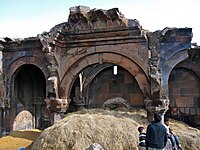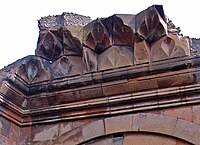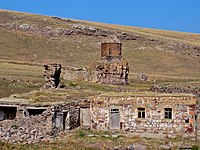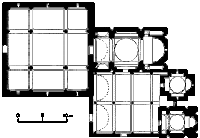| Bagnayr Monastery | |
|---|---|
 Bagnayr Monastery from the east, end of 19th century. Photo by Dimitri Yermakov Bagnayr Monastery from the east, end of 19th century. Photo by Dimitri Yermakov | |
| Religion | |
| Affiliation | Armenian Apostolic Church |
| Status | ruined |
| Location | |
| Location | Kozluca, Kars |
 | |
| Geographic coordinates | 40°30′46″N 43°29′09″E / 40.51278°N 43.48583°E / 40.51278; 43.48583 |
| Architecture | |
| Style | Armenian |
| Completed | 10th-13th century |
The Bagnayr Monastery is a monastery in Kozluca, Kars, 7 kilometers northwest of Ani, built in the 11th century CE. It was "one of the most renowned monastic complexes in medieval Armenia". The monastery was standing at the end of the 19th century, but is now almost completely in ruins.
Construction
According to Armenian sources, the 11th century historian Stepanos Asoghik, Vahram Pahlavouni (died 1046) founded the monastery in the year 989. The son of Vahram, Smbat Magistros Pahlavuni, is thought to have founded the main church, Surp Astuacacin, "Holy Mother of God". The church's oldest inscription is dated 1042. The monastery was a major religious center in the 1040s and the Pahlavunis maintained their patronage into the 13th century. Various inscriptions mention the construction of chapels in 1145, 1200, 1223 and 1229. The monastery was probably abandoned at the end of the 13th century.
Two walls and an arch vaulted door remain, but the annular vault of the door is ruined. At the internal section of the remaining walls, 5 arches and 5 dummy columns are interconnected and epitaphs are placed in between the columns. The middle dome and north wall of the church are collapsed and only 2 columns have remained. The top of the remaining south walls is decorated with geometrical designs in carving technique.
A large zhamatun, actually larger than the church, was built in the late 12th century, its oldest inscription dating to 1201. It is structured around four free-standing columns and eight engaged semi-columns, and its stone ceiling has nine compartments. The central compartment had a pyramidal vault with muqarnas stalactite moulding, which is considered similar to that of the Church of the Holy Apostles at Ani.
An hexagonal chapel stands north of the main complex, and is probably dated to the 9th or 10th century, given its similarity to the church of St. Gregory of the Abughamrents in Ani. This Küçük Kozluca Church, remains partially preserved. This six-foil domed church has lost all of the coverings, and almost all of the exterior stone blocks have been scavenged, but the basic structure remains intact.
Numerous dedicatory inscriptions have been found on the site.
Style
The columns are short and rather fat, and are decorated with muqarnas ornementation. Such decorations can also be found in Horomos Monastery (dated 1277) or the Menucihr Mosque (dated 1072-1086).
-
 Remains of the monastery
Remains of the monastery
-
 Bagnayr Monastery, zhamatun columns and arcades, and remain of the central vault decorated by muqarnas.
Bagnayr Monastery, zhamatun columns and arcades, and remain of the central vault decorated by muqarnas.
-
 Wall with muqarnas decorations.
Wall with muqarnas decorations.
-
 Bagnayr Monastery muqarnas.
Bagnayr Monastery muqarnas.
-
 Inscription of 1262 and 1267.
Inscription of 1262 and 1267.
-
 The hexagonal chapel, at a distance from the main monastery
The hexagonal chapel, at a distance from the main monastery
-
 Plan
Plan
Sources
- Karapetian, Samvel (2013). "The Inscriptions of Bagnayr Monastery" (PDF). VARDZK Research on Armenian Architecture. 9: 16–41.
References
- Karapetian 2013, p. 17.
- ^ Jukić Buča, Vendi; Gwirtzman, Kristina; Maranci, Christina (1 September 2020). "Armenian Ecclesiastical Sites in the Kars Province (Turkey): Current State, Preservation and Revalorization". Heritage & Society. 13 (3): 13–15. doi:10.1080/2159032X.2021.1968220.
- Karapetian 2013, p. 16 "Bagnayr was one of the most renowned monastic complexes in medieval Armenia ranking among such major spiritual and cultural centres close to Ani as Horomos, Shirakavan and Argina. It was founded by Prince Vahram's son Smbat the Master in 1010."
- ^ Karapetian 2013.
- Karapetian 2013, p. 19 The inscription: "In the year 491 (1042), in the days of Catholicos of Armenians, His Holiness Petros and King Gagik the Shahenshah, Ashot’s son, my sons and I, Grigor Tzaghik, had a desire to allocate my shops, purchased with my own means, which are opposite Vasil’s market, to Sourb Astvatzatzin of Bagnayr Monastery, through Prior Stepanos, for Vasil’s and his sons’ longevity, for the atonement of my (Grigor’s) sins and for the salvation of my sons’ souls. And Father Stepanos and the brethren pledged themselves to conduct an annual divine service in all churches on the feast day of Peter and Paul in memory of my brother Mukatli and in my own after I consign my soul to God. And if any prior impedes the liturgy in my memory, may he atone for my sins before the Lord. And if anybody, either young or old, from the midst of my kinsfolk or aliens, robs the holy monastery of this plot of land..., may they be cursed."
- Jean Michel Thierry, A Propos de quelques monuments chrétiens du Vilayet de Kars, Revue des Études Arméniennes XVII (1983), pp. 329-394.
- ^ Eastmond, Antony (1 January 2017). Tamta's World: The Life and Encounters of a Medieval Noblewoman from the Middle East to Mongolia. Cambridge University Press. p. 300. doi:10.1017/9781316711774.011.
Many of these overlaps come together in one building, the zhamatun that was added to the early eleventh-century church of the Holy Apostles in Ani some time shortly before 1217 (the earliest inscription on the building). Note 25: A date of around 1200 is supported by the similarity of the vaulting of the zhamatun of the monastery at Bagnayr, where the earliest inscription dates to 1201: Basmadjian, Inscriptions arméniennes d'Ani, no. 150.
- Karapetian 2013, p. 24 The inscription is: "In 650 (1201) I, Deval’s son Mkhitar, gave the holy monastery of Bagnayr my property... with my own efforts... in return for which, Hamsisar and the other brethren promised 2 divine services a year: one for my spouse and another for me... May God bless those who will observe this."
- "The situation of Christian architectural heritage in Turkey". Retrieved 13 March 2024.
- ^ Ani Cultural Landscape (PDF). Unesco. p. 31.
The similarity of short and fat columns with capitals bearing muqarnas ornamentation can be found inside the hall at the monastery of Horomos and Bagnayr Monasteries.
- Karapetian 2013, pp. 34–35
External links
- "Armenian Architecture - VirtualANI - Bagnayr Monastery". www.virtualani.org.
| Municipalities | |
|---|---|
| Villages |
|



